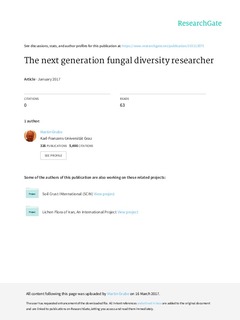| dc.contributor.author | Grube, Martin | |
| dc.contributor.author | Gaya, Ester | |
| dc.contributor.author | Kauserud, Håvard | |
| dc.contributor.author | Smith, Adrian M. | |
| dc.contributor.author | Avery, Simon V. | |
| dc.contributor.author | Fernstad, Sara F. | |
| dc.contributor.author | Muggia, Lucia | |
| dc.contributor.author | Martin, Michael D. | |
| dc.contributor.author | Eivindsen, Tove | |
| dc.contributor.author | Kõljalg, Urmas | |
| dc.contributor.author | Bendiksby, Mika | |
| dc.date.accessioned | 2017-03-23T09:33:10Z | |
| dc.date.available | 2017-03-23T09:33:10Z | |
| dc.date.created | 2017-03-22T11:19:43Z | |
| dc.date.issued | 2017 | |
| dc.identifier.citation | Fungal Biology Reviews(2017) | nb_NO |
| dc.identifier.issn | 1749-4613 | |
| dc.identifier.uri | http://hdl.handle.net/11250/2435127 | |
| dc.description.abstract | Fungi are more important to our lives than is assumed by the general public. They can comprise both devastating pathogens and plant-associated mutualists in nature, and several species have also become important workhorses of biotechnology. Fungal diversity research has in a short time transcended from a low-tech research area to a methodintensive high-tech discipline. With the advent of the new genomic and post-genomic methodologies, large quantities of new fungal data are currently becoming available each year. Whilst these new data and methodologies may help modern fungal diversity researchers to explore and discover the yet hidden diversity within a context of biological processes and organismal diversity, they need to be reconciled with the traditional approaches. Such a synthesis is actually difficult to accomplish given the current discouraging situation of fungal biology education, especially in the areas of biodiversity and taxonomic research. The number of fungal diversity researchers and taxonomists in academic institutions is decreasing, as are opportunities for mycological education in international curricula. How can we educate and stimulate students to pursue a career in fungal diversity research and taxonomy and avoid the situation whereby only those few institutions with strong financial support are able to conduct excellent research? Our short answer is that we need a combination of increased specialization and increased collaboration, i.e. that scientists with specialized expertise (e.g., in data generation, compilation, interpretation, and communication) consistently work together to generate and delivernew fungal knowledge in a more integrative manner e closing the gap between both traditional and modern approaches and academic and non-academic environments. Here we discuss how this perspective could be implemented in the training of the ‘next generation fungal diversity researcher’. | nb_NO |
| dc.language.iso | eng | nb_NO |
| dc.publisher | Elsevier | nb_NO |
| dc.title | The next generation fungal diversity researcher | nb_NO |
| dc.type | Journal article | nb_NO |
| dc.type | Peer reviewed | nb_NO |
| dc.source.journal | Fungal Biology Reviews | nb_NO |
| dc.identifier.doi | 10.1016/j.fbr.2017.02.001 | |
| dc.identifier.cristin | 1460292 | |
| dc.relation.project | Norges teknisk-naturvitenskapelige universitet: PES midler | nb_NO |
| dc.description.localcode | © 2017 British Mycological Society. Published by Elsevier Ltd. All rights reserved. This is the authors' accepted manuscript to the article. Locked until 31st of March 2018 due to copyright restrictions. | nb_NO |
| cristin.unitcode | 194,31,1,0 | |
| cristin.unitcode | 194,31,10,0 | |
| cristin.unitname | Vitenskapsmuseet administrasjon | |
| cristin.unitname | Seksjon for naturhistorie | |
| cristin.ispublished | false | |
| cristin.fulltext | postprint | |
| cristin.qualitycode | 1 | |
